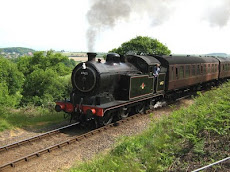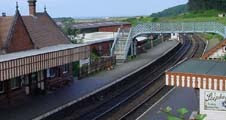There are over 100 heritage railways in Britain that operate regular schedules 300 out of 365 days of the year. Okay, maybe not 300 out of 365 days but certainly more than just running weekends. There are a number of factors that contribute to this.
Firstly, the heritage railways have developed a large cadre of volunteers. And they make good use of their volunteers to the extent that the volunteers have skills in all aspects of running the railways, whether it's keeping the locomotives in running order, rebuilding the carriages, maintaining the trackwork, doing the signalling, running the trains, promoting the railway, and, most importantly, giving their visitors an experience they will remember.
 |
| Sheringham Station With Network Rail In The Background |
In May and June of 2010 I volunteered for 6 weeks in the carriage-and-wagon shop on the North Norfolk Railway. This 5-mile line with stations top-and-bottom at Holt and Sheringham, and in the middle at Weybourne, has a cadre of 450 volunteers and 35 part-time employees. With an advertised regular schedule, the employees are required just in case a volunteer doesn't show up for their shift. I could tell what day of the week it was by who showed up in the shop. They get 150,000 visitors a year which results in an annual net profit of £180,000 ($330,000). The Bluebell Railway (at the end of the line from Victoria Station in London) attracts over 300,000 visitors a year and operates with a cadre of 950 volunteers. I've visited the West Somerset Railway and the Swanage Railway and they too operate under the same premise - the railways are run by the volunteers.
 |
| The NNR Shops & Yard At Weybourne. Carriage and wagon shops on the far right, locomotive shops on the left, mainline on the bottom left. |
 |
| Tea time in the NNR Carriage & Wagon Shop |
I was there in the locomotive shop when a newbie showed up to volunteer. "What do you do?" "I run trains out of London. I'd like to run trains here but I understand I'd have to wait 6 months for driver training and testing" says Newbie. "Oh, that's no problem at all", says Allistair. "I'm the guy who does the training and testing. When are you free?". Two weeks later I saw Newbie in the engineman's seat with Allistair sitting behind him. Be careful what you wish for, eh!? On British heritage railways, you'll get your wish. "Hey Bob", says Allistair from the Cab of his Class 37 diesel undergoing rebuild in the locomotive shop. "Want a tour of our diesel?" How Allistair and 8 of his buddies got a Class 37 diesel .... well ....... that's another story!
 |
| Allistair & his buddies' Class 37 undergoing rebuild in the locomotive shops. Since I took this photo, D6732 went back into operation in the fall of 2013. |
 |
| Inside The Carriage & Wagon Shop. Scaffolding has been moved to bring in another Mark 1 passenger car for rebuild. |
They are subject to the same kinds of rules and inspections as the commercial railways operating on the British network. And those rules include safety rules, whether it's on the line or in the shops. Most of the heritage railways operate under a "token" system for train movement which is probably one of the safest methods for controlling the movement of trains. No token and the signalman can't move the points on the switch to release the train onto the next section of track.
 |
| Sunday Crowd in the Afternoon at Holt |
They maintain contact with their volunteers and members through monthly or quarterly publications. My North Norfolk Railway quarterly "Joint Line" has kept me up to date with what's been happening for the last four years. The publication is very well done - high quality paper, lots of colour photos, well written articles, excellent editing, lots of news about what's going on, and what the plans are for the future.
My decision to visit the North Norfolk started with a membership in the summer of 2009 and the genesis of one of their major projects. In September as I was preparing for my trip, their gameplan was to connect with the national Network Rail which ended just across the street from NNR's Sheringham Station. They needed £100,000 ($182,000) to do the job.
Out went the appeal. Plans were submitted to the local governments for approval. The workplan and sequencing of activities was laid out in detail as timing was most critical. Volunteers were lined up. Contractors for technical parts like re-locating telephone cables and underground electrical wires were arranged. And the money came pouring in from all corners of the country! (And a small bit even came from Canada.) By January 1st, the project was all set go!
Each Monday after the completion of the weekend's work, a video was posted on the NNR's YouTube channel. Each Monday I could hardly wait to see the progress that was being made. On March 11, 2010, "Oliver Cromwell" steamed up from London's Kings Cross station and, with 8,000 visitors looking on, took the crossing - the first time since 1967 that a mainline locomotive had done so. As I stepped off the train at Sheringham on May 12th and walked across the street to the NNR station, it was quite a thrill to walk across the level crossing that I'd been following the preceding 4 months on YouTube.
 |
| "Oliver Cromwell" On The New Level Crossing At Sheringham |
The top project will see the movement of Chatham Steam, a boiler and locomotive rebuild shop, moving from Chatham to the NNR's Weybourne shops. This will require moving the existing NNR machine shop and the construction of a new machine shop, extra pits, and more trackage. Plans and approvals are in hand as is the money. New contracts from other heritage railways will keep the rebuild shop going for the next two years with new inquiries coming in each week.
They have a very large education program with over 600 students taking part every year. Plans are underway to build a new education facility at the end of the line at Holt Station to replace the old passenger carriages that have been used for these purposes. And the restoration, rebuild, and maintenance of the existing stock of locomotives and Mark 1 carriages continues. Trackwork and signalling is upgraded and maintained. New "heritage" wagons come in, are rebuilt, and end up on the tracks after inspection by Her Majesty's Railway Inspector (I kid you not!) for their gala weekends.
 |
| Wisbech & Upswell #7 out on the line after Inspection by HMRI. This was the last coach I worked on before returning home. |
I could go on-and-on about how private locomotives are kept on the line, how they are able to raise money for locomotive rebuilds, how they plan on steam train movements on Network Rail from Sheringham to Cromer on Sundays, their relationships with Network Rail, with Anglia Trains, but that would take up too much space.
All in all, it's something they have but we don't. But I'd sure like to get a bit of it over here! Perhaps the Hull Chelsea Wakefield would be in operation by now..... Or the Shay would be ready for rebuild...... Or #40 would be on display in the locomotive hall....... Or #1201 would be ready for steam........
Or .................. whatever else you'd like to dream.............!

